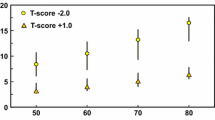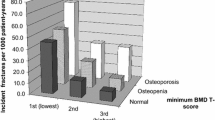Abstract
Summary
Early prognosis of osteoporosis risk is not only important to individual patients but is also a key factor when screening for osteoporosis drug trial populations. We present an osteoporosis fracture risk score based on vertebral heights. The score separated individuals who sustained fractures (by follow-up after 6.3 years) from healthy controls at baseline.
Introduction
This case–control study was designed to assess the ability of three novel fracture risk scoring methods to predict first incident lumbar vertebral fractures in postmenopausal women matched for classical risk factors such as BMD, BMI, and age.
Methods
This was a case–control study of 126 postmenopausal women, 25 of whom sustained at least one incident lumbar fracture and 101 controls that maintained skeletal integrity over a 6.3-year period. Three methods for fracture risk assessment were developed and tested. They are based on anterior, middle, and posterior vertebral heights measured from vertebrae T12-L5 in lumbar radiographs at baseline. Each score’s fracture prediction potential was investigated in two variants using (1) measurements from the single most deformed vertebra or (2) average measurements across vertebrae T12-L5. Emphasis was given to the vertebral fracture risk (VFR) score.
Results
All scoring methods demonstrated significant separation of cases from controls at baseline. Specifically, for the VFR score, cases and controls were significantly different (0.67 ± 0.04 vs. 0.35 ± 0.03, p < 10 −6) with an AUC of 0.82. Dividing the VFR scores into tertiles, the fracture odds ratio for the highest versus lowest tertile was 35 (p < 0.001). Sorting the combined case–control group according to VFR score resulted in 90% of cases in the top half.
Conclusion
At baseline, the three scores separated cases from controls and, especially, the VFR score appears to be predictive of fractures. Control experiments, however also, indicate that VFR-based fracture prediction is operator/annotator dependent and high-quality annotations are needed for good fracture prediction





Similar content being viewed by others
References
Rodan GA, Martin TJ (2000) Therapeutic approaches to bone diseases. Science 289:1508
Watts NB (2001) Osteoporotic vertebral fractures. Neurosurg Focus E12:10
Kanis JA, Borgstrom F, De Laet C, Johansson H, Johnell O, Jonsson B, Oden A, Zethraeus N, Pfleger B, Khaltaev N (2005) Assessment of fracture risk. Osteoporos Int 16:581–589
Truumees E (2003) Medical consequences of osteoporotic vertebral compression fractures. Instr Course Lect 52:551–558
Jiang G, Eastell R, Barrington NA, Ferrar L (2004) Comparison of methods for the visual identification of prevalent vertebral fracture in osteoporosis. Osteoporos Int 17(11):887–896
Genant HK, Wu CY, van Kuijk C, Nevitt MC (1993) Vertebral fracture assessment using a semiquantitative technique. J Bone Miner Res 8:1137–1148
Ferrar L, Jiang G, Adams J, Eastell R (2005) Identification of vertebral fractures: an update. Osteoporos Int 16:717–728
Grados F, Roux C, de Vernejoul MC, Utard G, Sebert JL, Fardellone P (2001) Comparison of four morphometric definitions and a semiquantitative consensus reading for assessing prevalent vertebral fractures. Osteoporos Int 12:716–722
O’Neill TW, Felsenberg D, Varlow J (2004) Diagnosis of osteoporotic vertebral fractures: importance of recognition and description by radiologists. Am J Roentgenol 183:949–958
Stone J, Gurrin LC, Byrnes GB, Schroen CJ, Treloar SA, Padilla EJ, Dite GS, Southey MC, Hayes VM, Hopper JL (2007) Mammographic density and candidate gene variants: a twins and sisters study. Cancer Epidemiol Biomark Prev 16:1479–1484
Nielsen VAH, Pødenphant J, Martens S, Gotfredsen A, Riis BJ (1991) Precision in assessment of osteoporosis from spine radiographs. Euro K Radiol 13:11–14
Delmas PD, Langerijt L, Watts NB, Eastell R, Genant H, Grauer A, Cahall DL (2005) Underdiagnosis of vertebral fractures is a worldwide problem: the IMPACT study. J Bone Miner Res 20:557–563
Eastell R, Cedel SL, Wahner HW, Riggs BL, Melton LJ (1991) Classification of vertebral fractures. J Bone miner Res (Print) 6:207–215
Black DM, Palermo L, Nevitt MC, Genant HK, Epstein R, San Valentin R, Cummings SR (1995) Comparison of methods for defining prevalent vertebral deformities: the Study of Osteoporotic Fractures. J Bone Miner Res 10:890–902
Davies KM, Recker RR, Heaney RP (1989) Normal vertebral dimensions and normal variation in serial measurements of vertebrae. J Bone Miner Res 4:341–349
Jensen KK, Tougaard L (1981) A simple X-ray method for monitoring progress of osteoporosis. Lancet 2:19–20
Kleerekoper M, Parfitt AM, Ellis BI (1984) Measurement of vertebral fracture rates in osteoporosis. Copenhagen Int Symp Osteoporos 1:103–108
Melton LJ, Kan SH, Frye MA, Wahner HW, O’Fallon WM, Riggs BL (2005) Epidemiology of vertebral fractures in women. Am J Epidemiol 129:1000–1011
Minne HW, Leidig G, Wuster C, Siromachkostov L, Baldauf G, Bickel R, Sauer P, Lojen M, Ziegler R (1988) A newly developed spine deformity index (SDI) to quantitate vertebral crush fractures in patients with osteoporosis. Bone Miner 3:335–349
Reshef A, Schwartz A, Ben Menachem Y, Menczel J, Guggenheim K (1971) Radiological osteoporosis: correlation with dietary and biochemical findings. J Am Geriatr Soc 19:391–402
Ross PD, Yhee YK, He YF, Davis JW, Kamimoto C, Epstein RS, Wasnich RD (1993) A new method for vertebral fracture diagnosis. J Bone Miner Res 8:167–174
Smith-Bindman R, Steiger P, Cummings SR, Genant HK (1991) The index of radiographic area (IRA): a new approach to estimating the severity of vertebral deformity. Bone Miner 15:137–149
McCloskey EV, Spector TD, Eyres KS, Fern ED, O’Rourke N, Vasikaran S, Kanis JA (1993) The assessment of vertebral deformity: a method for use in population studies and clinical trials. Osteoporos Int 3(3):138–147
Bagger YZ, Tanko LB, Alexandersen P, Hansen HB, Qin G, Christiansen C (2006) The long-term predictive value of bone mineral density measurements for fracture risk is independent of the site of measurement and the age at diagnosis: results from the prospective epidemiological risk factors study. Osteoporos Int 17:471–477
Pettersen PC, de Bruijne M, Chen J, He Q, Christiansen C, Tanko LB (2007) A computer-based measure of irregularity in vertebral alignment is a BMD-independent predictor of fracture risk in postmenopausal women. Osteoporos Int 18(11):1525–1530
DeLong ER, DeLong DM, Clarke-Pearson DL (1988) Comparing the areas under two or more correlated receiver operating characteristic curves: a nonparametric approach. Biometrics 44:837–845
Tarone RE (1985) On heterogeneity tests based on efficient scores. Biometrika 72(1):91–95
Zebaze RMD, Maalouf G, Maalouf N, Seeman E (2004) Loss of regularity in the curvature of the thoracolumbar spine: a measure of structural failure. J Bone Miner Res 19:1099–1104
Duan Y, Seeman E, Turner CH (2001) The biomechanical basis of vertebral body fragility in men and women. J Bone Miner Res 16:2276–2283
Hasserius R, Karlsson MK, Nilsson BE, Johnell O (2003) Prevalent vertebral deformities predict increased mortality and increased fracture rate in both men and women: a 10-year population-based study of 598 individuals from the Swedish cohort in the European Vertebral Osteoporosis Study. Osteoporos Int 14:61–68
Lunt M, O’Neill TW, Felsenberg D, Reeve J, Kanis JA, Cooper C, Silman AJ (2003) Characteristics of a prevalent vertebral deformity predict subsequent vertebral fracture: results from the European Prospective Osteoporosis Study (EPOS). Bone 33:505–513
Acknowledgements
The authors gratefully acknowledge the funding from the Danish Research Foundation (Den Danske Forskningsfond) supporting this work. The authors thank Jane Petersen and Annette Olesen for the repeat annotations.
Conflicts of interest
The VFR-methodology is part of a pending patent. Martin Lillholm is an employee of Synarc Imaging Techonologies/Nordic Bioscience Imaging (SIT/NBI). Anarta Ghosh is a former employee of SIT/NBI. Paola C Pettersen is an employee of Center for Clinical and Basic Research (CCBR). Erik B Dam is an employee of SIT/NBI. Morten A Karsdal is an employee and shareholder of Nordic Bioscience (NB). Claus Christiansen is an employee and shareholder of NB and CCBR. Harry K Genant is an employee and shareholder of Synarc. Mads Nielsen is partly funded by SIT/NBI. Marleen de Bruijne was previously funded by Nordic Bioscience.
Author information
Authors and Affiliations
Corresponding author
Rights and permissions
About this article
Cite this article
Lillholm, M., Ghosh, A., Pettersen, P.C. et al. Vertebral fracture risk (VFR) score for fracture prediction in postmenopausal women. Osteoporos Int 22, 2119–2128 (2011). https://doi.org/10.1007/s00198-010-1436-6
Received:
Accepted:
Published:
Issue Date:
DOI: https://doi.org/10.1007/s00198-010-1436-6




